
Symbolism - II
Xavier Mellery
1845 - 1921
Xavier Mellery (9 August 1845, Laken – 4 February 1921, Brussels) was a Belgian symbolist painter.
The son of a gardener at the Royal Palace of Laeken, Mellery initially worked with the painter-decorator Charles Albert. He attended the Royal Academy of Fine Arts of Brussels from 1860 to 1867, one of his professors being Jean-François Portaels. Mellery won the Prix de Rome and traveled to Italy where he studied paintings from the Renaissance. His works include The Rondo of the Hours.
Mellery designed the statues of all 48 historical professions in the Petit Sablon/Kleine Zavel garden in Brussels, though they were executed by different sculptors. Each pillar has a unique design, as does each section of fence.

Self-portrait

Danse
1888

My Hallway, Light Effect
1889

Immortality
c.1890

Bruges
1890

The Tenderness is The Daughter Of The Force
1890

Autumn
1893

Eternity and Death

Mother pride

The Roman Vault
Luis Ricardo Falero
1851 – 1896
Luis Ricardo Falero (May 23, 1851 – December 7, 1896) was a Spanish painter. He specialized in female nudes and mythological, orientalist and fantasy settings. His most common medium was oil on canvas. Falero’s paintings are held mostly within private collections in Europe and the United States, although a watercolour of the ‘Twin Stars’ is in the collection of the Metropolitan Museum of Art, New York.

Self-portrait

Witches on the Sabbath (1878)

Les Nymphes

The Enchantress (1878)

Posing (1879)

Faust's Dream (1880)

Festival of the Witches (1880)

Fairy Under Starry Skies

Prayer to Isis (1883)

The witch, painted on a tambourine (1882)

An allegory of art (1892)

Oriental Beauty

The Favorite

Fiesta in the Tavern (1880)

A Classical Beauty

Reclining Nude
Mikhail Vrubel
1856 — 1910

Mikhail Aleksandrovich Vroubel—he was born in Omsk in 1856—want to be embodied in his last work, The Fallen Angel which was directly inspired by Lermontov, and in the descendants of the Satanic heroes of the English poets John Milton and William Blake?
This work, combining reality and vision, irresistibly recalls a painting he completed four years ago: The Swan Princess. There is the influence of Byzantine art so dear to Vroubel which, as he says, differs profoundly from the art of the Italian Renaissance because its essence resides in ornamental order. The effect of fantasy is clearly accentuated in the two paintings by the decorative character of some of the details, like the feathers that form the angel's bedding as well as the princess's arm.
The immense solitude of Vroubel's subjects is his own. He is increasingly the prisoner of a mental illness. It cuts him off from reality and all possible communication, except for painting, into which he plunges with heroic and desperate energy.
Considered for two decades by the critic Repine as one of the greatest spirits of new Russian art, Vroubel is a member of the group called "The World of Art,” formed in 1890 by the artist and decorator Alexander Benois and enlivened by Sergei de Diaghilev.
Self-portrait, 1885

The Swan Princess, 1900.

Tamara and Demon. Illustration to Lermontov's poem, 1890.
_-_Google_Art_Project.jpg)
The Demon Seated, 1890.

The Lilacs, 1900.

Demon Downcast, 1902.
__1904.jpg)
Six-winged Seraph, 1904.

Portrait of a Girl against a Persian Carpet, 1886.
.jpg)
Morning, 1897.

Pan, 1899

Portrait of the painter's son, 1902

The Pearl Shell, 1904

Tombstone Crying, the second version. Akvarel, 1887.
Fernand Khnopff
1858 - 1921

Fernand Edmond Jean Marie Khnopff (12 September 1858 – 12 November 1921) was a Belgian symbolist painter.
Fernand Khnopff was born to a wealthy family that was part of the high bourgeoisie for generations. Khnopff's ancestors had lived in the Vossenhoek area of Grembergen Flanders since the early 17th century but were of Austrian and Portuguese descent. Most male members of his family had been lawyers or judges, and young Fernand was destined for a juridical career. In his early childhood (1859–1864), he lived in Bruges where his father was appointed Substitut Du Procureur Du Roi. His childhood memories of the medieval city of Bruges would play a significant role in his later work. In 1864, the family moved to Brussels. In his childhood Khnopff spent part of his summer holidays in the hamlet of Tillet not so far from Bastogne in the Luxemburg province where his maternal grand parents owned an estate. He painted several views of this village.
Fernand Khnopff

Portrait of Marguerite Khnopff (1887)

Silence, 1890

Memories or Lawn Tennis, 1889

Caress of the Sphinx, 1896
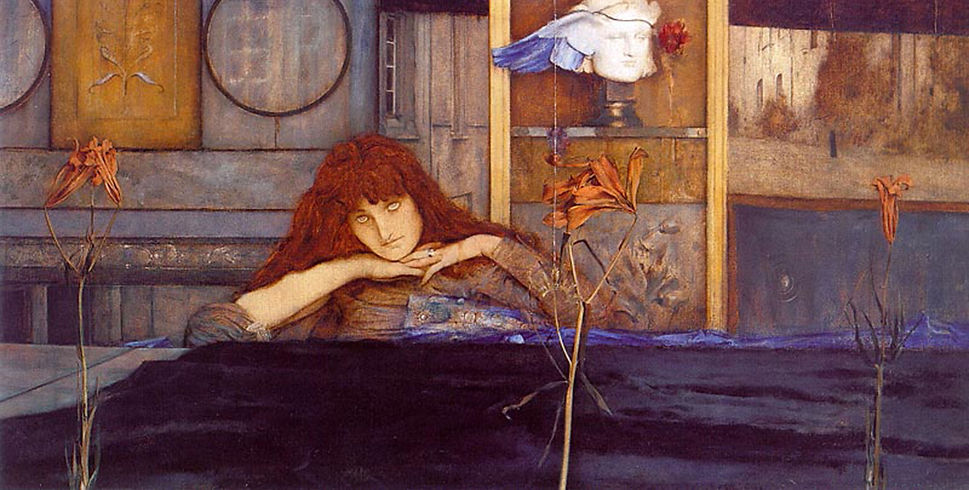
I lock my door upon myself

A Blue Wing
1894

After Joséphin Péladan, The Supreme Vice
1885

The Blood of Medusa
1898

Sleeping Medusa
1909

Paganism
c. 1910

Brutishness
1885
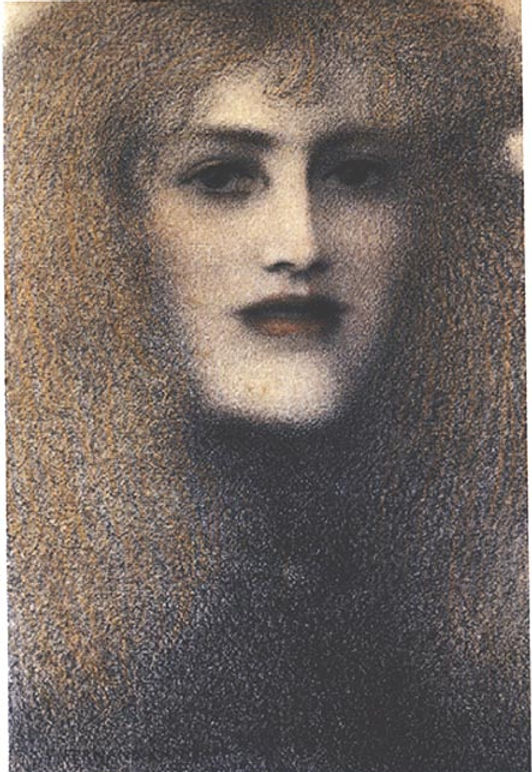
Rote Lippen [Red Lips]
1897

Mask with Black Curtain
1909

Who Shall Deliver Me?
1898

Dreaming Woman — Nevermore
c. 1900

The Offering
1891

Brown Eyes and a Blue Flower
c. 1900

Woman of Mystery
c. 1909
Franz von Stuck
1863 - 1928

Self-Portrait
Franz von Stuck (b Tettenweis, Lower Bavaria, 23 Feb 1863; d Munich, 30 Aug 1928). German draughtsman, illustrator, printmaker, decorative artist, painter, sculptor and architect. He was noted for his treatment of erotic and comic aspects of mythological themes. He drew eagerly as a child, soon becoming a gifted caricaturist. From 1878 to 1881 he attended the Kunstgewerbeschule in Munich, where he received particular encouragement from Ferdinand Barth (1842–92). From 1881 to 1885 he studied at the Munich Akademie, where he was taught by Wilhelm Lindenschmit (1829–95) and Ferdinand Lofftz (1845–1910). During his student years Stuck earned a living from designs for decorative painting, and he made notable contributions (1880–84) to the humorous Munich periodical Fliegende Blätter and to the Viennese serial publications Allegorien und Embleme and Karten und Vignetten. These did much to establish his reputation as both a skilled and a witty draughtsman.

Wounded Amazon 1904

Boy Bacchus Riding on a Panther

The Kiss of the Sphinx 1895

Sin
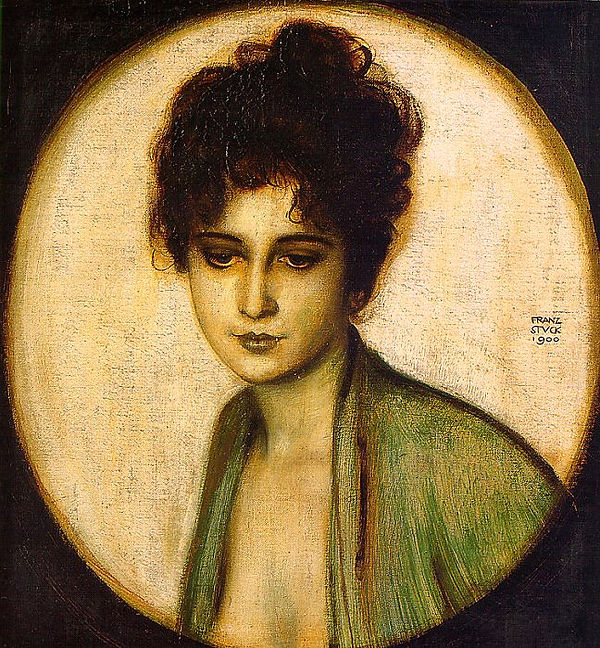
Portrait of Frau Feez

Susanna Bathing

Sisyphus

Salome
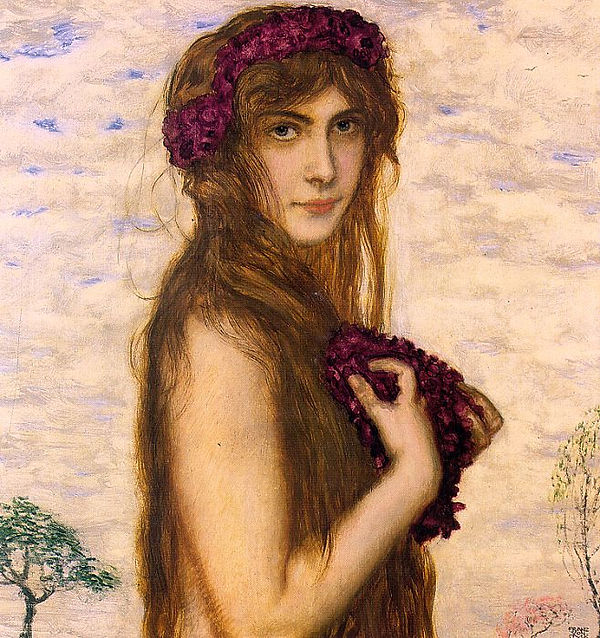
Spring

Lucifer

The Sphinx

Judith and Holofernes

Der Kampf ums Weib

Judith und Holofernes

Susanna im Bade
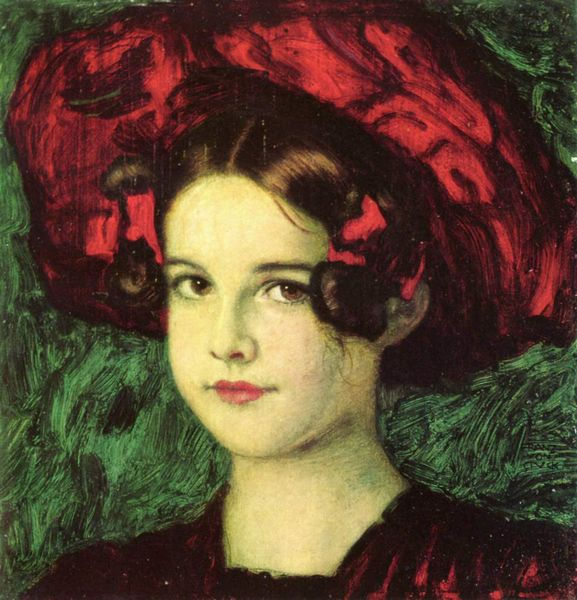
Mary mit rotem Hut

Orpheus

Tilla Durieux als Circe

Dancers, 1896

Adam and Eve, 1920